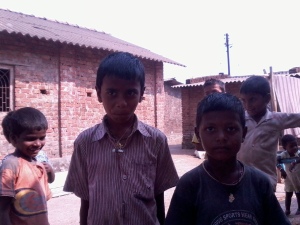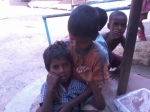Last month I got an opportunity to visit this village named Tarankop. It is a small hamlet, around 30 odd kilometers ahead of Panvel. Cause – a medical /food distribution camp in the nearby adivasi padas.
Well, these adivasi padas consists of around 40-50 families each. The condition of the people over here is a shocking example of how little India has achieved even after over 60 years of independence. With a mega city like Mumbai, dreaming to be a financial hub for the region, just 100 kms away the difference cannot be more contrasting.
We had carried some some food stuff which was to be distributed amongst the villagers followed by their medical check-up. Along with this, we also provided them with basic medicines, where ever necessary.
Out of the 20 – odd small mud houses there was one small structure with a board, which read “Pradhan mantri Sarv shiksha abhiyan”(meaning Prime Minister’s Educate All Program).
This was the primary school for the village kids. The villagers told us there was a single teacher who conducts all the classes simultaneously in one single room. The entire setup is very demotivating and hardly any child ends up completing the primary level. Even if a kid completes it, the secondary school is almost five kilometers away from the village. As we traversed more through this place, we realized how the entire area has been left way behind as far as development of infrastructure and human resource is concerned. With not even a pucca road to the village, expecting public transport would be a bit too much. Children are required to walk their way to school daily. Apart from this, the acute poverty forces the villagers to put there children to work and in case of girls, just marry them off.
Even basic necessity like food is considered a luxury over here. A small pack of Parle-G brought so much joy on their face. The only reason why the kids go to school is for the lunch which is served as part of the governments “mid-day meal” program. A local social worker has made arrangement for water from a nearby water pipeline. Electricity is being shared from the connection to school and a small GramPanchayat office. Each home wouldn’t be having more than one or two bulbs. Most of the kids here appeared to be undernourished. The village does not have medical facility anywhere nearby. Kids have bruise marks which take long time to heal without medication. Women have no one to approach with their medical issues and their men could not afford taking them to nearby town for regular checkups.
Most of the villagers depend on agriculture and related activities for their livelihood. But unlike other farmers they do not have land of their own. For generations they have been forced to work on other people’s farm. The region is not very much blessed as far farm irrigation is concerned. Hence farming activities happen only in the monsoon period. For the other part of the year they do not have dependable source of earning. Add to this the meager wages they earn and scene appears a lot more serious. With such a hand to mouth situation these people are hardly left with anything which they can save and utilize sometime later. They do not have access to banks. They do not know what investment is, not even postal schemes. For occasions like marriages, pregnancies or any other emergency they are forced to take loans from local elites on very high interest rates as banks do not lend to them. Paying back such loans eats up most of their lifetime else it is passed on to their children.
This is the plight of two hamlets which we happened to visit. But certainly there are thousands of such villages/hamlets in India where the situation is similar if not worse. With India having more than 50% of its population in the 15-55 years age group, most of our population is in the working age group. But with children not getting opportunities to learn and educate themselves, how can they, and in turn the entire country, gain from this Demographic dividend? On one side the country is thinking of competing with major economies like the US, China, UK etc, yet 60% of our population is still dependent on agriculture, Which again is heavily dependent on monsoon. The plight of these young children is pathetic. With lack of appropriate opportunities, one realizes how a crucial resource is being wasted.
Countries like Japan, Italy, France etc are experiencing reduction in their population. Also they have more number of people in the non-working age group i.e. they have more number of people who are dependent on the working age group compared to countries like India, China and the US. India which will be experiencing purple patch of demographic dividend for next few decades. This gives her a unique opportunity which needs to be carefully capitalized on.
With the economy growing at a blistering pace and government initiating programs like UID, NREGA etc, some positive changes shall certainly happen. But we from our end can also do our bit. It’s not always money which stands as a constraint in development. People like these adivasis are basically just uninformed. They are not aware of many things which are available to them. Guiding them, making them aware of different employment possibilities will certainly help them. More than contributing money, spending some time on planning and executing shall go a long way. A similar case study is availaible in the article : The Real Deal on “Economic Times” . Lets do our bit in our individual capacity. Let’s try and bring some joy on these faces.



